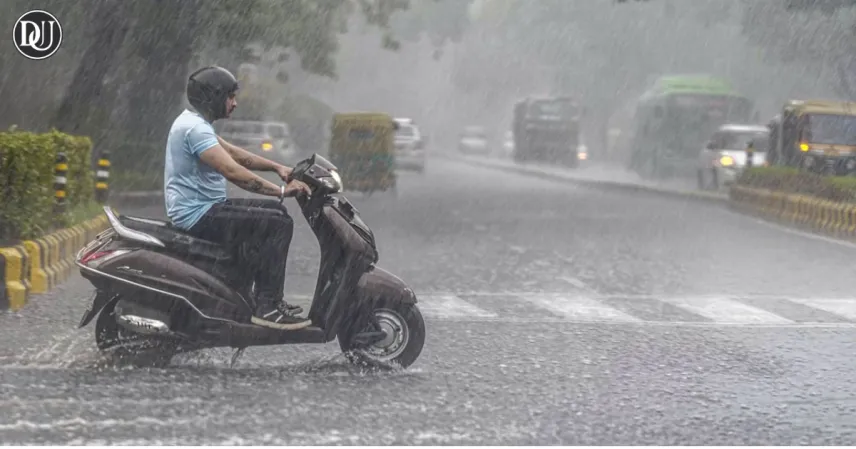Delhi and its surrounding NCR regions woke up to waterlogged streets, traffic chaos, and widespread disruptions as torrential rain poured down across the city on July 10. The Indian Meteorological Department (IMD) upgraded its weather warning for the region from an orange alert to a red alert, signaling the potential for severe disruption.
The sudden surge in rainfall led to overflowing drains, submerged roads, and delayed flights, turning a regular monsoon day into a logistical nightmare for thousands of commuters. With the IMD issuing a severe rainfall alert, officials have urged residents to remain cautious and avoid unnecessary travel.
What Does a Red Alert Mean?
A red alert from the IMD is the highest level of warning and is issued when heavy to extremely heavy rainfall is expected over a specific area, likely leading to damage, flooding, and significant disruption of routine activities. It is an appeal for authorities and citizens to be on full alert.
This severe rainfall alert indicates that rainfall exceeding 204.5 mm in 24 hours could occur in affected areas. The IMD also warned that localized flooding, especially in low-lying parts of Delhi, Noida, and Gurugram, could persist for the next 24 to 48 hours.
How the Rain Affected Daily Life
Delhi’s arterial roads, including stretches near ITO, Connaught Place, and South Extension, saw heavy waterlogging. Traffic crawled through key junctions, with reports of vehicles stalling in knee-deep water. Metro services ran smoothly overall, but access to some stations was hampered due to flooding outside.
In Gurugram, office-goers reported extended commute times, and in Noida, schools began sending early dismissal alerts due to worsening road conditions. The severe rainfall alert also affected domestic air travel, with delays at Indira Gandhi International Airport due to poor visibility and runway flooding.
Government’s Response and Emergency Steps
In response to the alert, the Delhi Disaster Management Authority activated emergency protocols. Pumping stations were deployed in waterlogged zones, while civil defense volunteers were stationed across major intersections to assist traffic police.
Public advisories have been issued, instructing citizens to stay indoors, avoid underpasses and subways, and check weather updates before venturing out. Authorities are also monitoring the situation to decide whether further restrictions or closures are necessary.
Why Is Delhi Receiving So Much Rain?
Delhi is currently in the active phase of the southwest monsoon. Meteorologists explain that the recent rainfall is a result of a low-pressure system over central India that has moved northward. This system, when combined with high humidity from the Bay of Bengal, has caused continuous cloud formation and rainfall over North India.
The IMD notes that such systems are not unusual, but the volume of rainfall this year has been more intense than expected. With climate change contributing to erratic monsoon patterns, severe rainfall alerts may become increasingly frequent.
Rain-Related Incidents and Safety Concerns
Several minor accidents and disruptions were reported. A tree fell on a parked car in Lajpat Nagar, and a portion of a wall collapsed in Karol Bagh, though no injuries were reported. Emergency teams responded promptly, and cleanup operations began immediately after.
In residential colonies like Mayur Vihar, residents shared images of flooded basements and overflowing manholes. Civic authorities have been pressed into action to prevent the spread of waterborne diseases as stagnant water accumulates.
Neighboring States Also on Alert
Alongside Delhi, parts of Haryana, western Uttar Pradesh, and northern Madhya Pradesh are also under watch. Cities like Bhopal and Indore have already seen substantial rainfall, and Himachal Pradesh is facing landslide risks due to the moisture-laden atmosphere.
These areas may also experience similar weather conditions as Delhi due to the spread of the current low-pressure zone, as highlighted in the IMD’s severe rainfall alert across North and Central India.
What Can Residents Do?
The government is advising all residents to stay updated through the IMD app and official Delhi Disaster Management social media handles. Households are advised to store drinking water, secure outdoor items, and check electrical connections near flooded areas.
Those who must step out are urged to wear waterproof footwear, carry umbrellas or raincoats, and avoid venturing into unknown flooded paths. For families living in low-lying areas, evacuation arrangements have been made in coordination with local ward officers.
The Bigger Picture: Preparing for Extreme Weather
This event underscores the growing need for climate resilience in urban planning. Infrastructure in Delhi, including drainage systems and road engineering, requires urgent upgrades to handle extreme rainfall events.
While today’s disruptions may be temporary, the long-term solution involves strategic planning and community awareness. The current severe rainfall alert is both a challenge and a lesson for policymakers, urging them to invest in adaptive systems and smarter weather forecasting tools.










